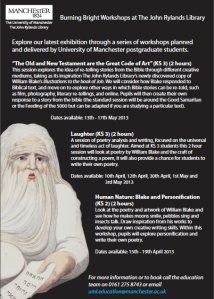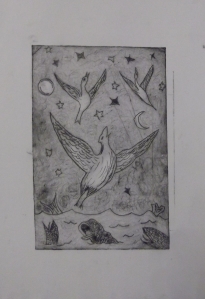I haven’t posted in a while; this is largely owing to spending too much time at my computer, rather than too little.
I spent much of last week manacled to my laptop working on the text for the online version of the John Rylands Library’s Blake exhibition. It’s a curious process re-writing an exhibition for an online manifestation — it will basically follow the physical exhibition in terms of the groupings of works but it will be quite a different beast in a number of ways.
Obviously the “visitor” will lose the physical experience of seeing each item discussed, and in this case, working within the structure of the University’s website, it will only be possible to have a “slice” of each image “on show” alongside the explanatory text (although the full image will be available to open in a separate window).
On the other hand, given that the exhibition focuses on Blake and the art of the book, a major limitation for the physical exhibition is that it is only possible to show one opening for each volume; in the online exhibition, it will be possible to showcase multiple pages.
The research has taken me to areas I might not otherwise have looked at in as much detail, which has both broadened my horizons and made me spot things which may actually have a bearing on some of the works I am looking at for my thesis.
This week I did get away from the computer a bit more, using some of the research I’ve been doing in relation to the web exhibition in a collection-based session at the Library on Blake and the Gothic. Blake was fascinated by the Gothic and the Library is a magnificent late-Victorian neo-Gothic building (images of the building are available via the University’s online image collections, LUNA).
The Gothic qualities of Blake’s works was also one of the reasons why he appealed to Victorian critics, artists and designers; the reception of Blake by these figures is one of the themes of the exhibition. In the collection encounter we also showed items associated with the Gothic phenomenon, such as Walpole’s Castle of Otranto and some spooky plates by Fuseli et al from Boydell’s Shakespeare Gallery. My online exhibition text will discuss all this material so watch this space.
I ran this tour twice; for one session I actually had just one visitor, but this made it much more of a conversation which was rather nice.
I also went down (or up) to Cambridge to a conference of visualising the Bible in the nineteenth-century; in fact it was very much mid-nineteenth century, so complemented my forays into the Gothic revival and Blake’s Victorian commentators. It was also a good opportunity to see some old friends and walk some dogs.
Now to refocus my doors of perception on Blake himself and get my first chapter of my thesis drafted.
And I almost forgot, I went to the Tate a couple of weeks ago to see their new dedicated Blake room. They have re-displayed their collection in a chronological hang, but together with Turner, Blake is divorced from his context, in his own chamber-like (maybe even church-like) space which one can access without passing through any other gallery. I’ve mixed feelings about this consequence of the new hang, but it was certainly a treat to spend time surrounded by Blakes!


You must be logged in to post a comment.